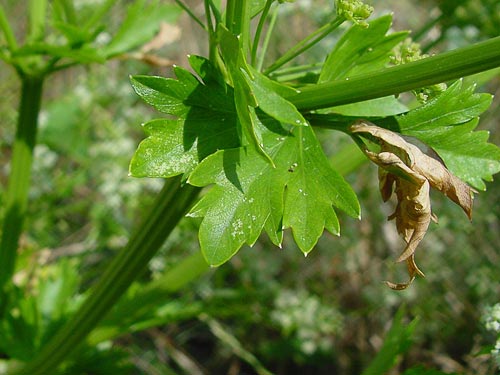Relatives
Apium graveolens L. - Celery, common celery.
Taxonomic position.
Family: Apiaceae (Umbelliferae); genus: Apium L.Morphology and biology.
Annual and biennial plant. Root is fusiform, branchy, lignifying in the second year; with the cultivated forms it is fleshy, orbicular-napiform. Stem is straight, 30-100 cm high, furrowed, often hollow inside, with many branches deviating from the base of the stem. Leaves are set on long, sometimes fleshy stalks; the first three are trifid, next ones are pinnate, those on top of the stem are sometimes opposite, almost sessile, positioned on short sheaths that are filmy at the edge. Primary lobes of the lower leaves are orbicular, obtuse at the base, trilobate or tripartite, dentate, with sharp denticles along the edge. Lobes of cauline leaves have a wedge-shaped base and margins with sharp whitish cartilaginous denticles. Umbels are numerous, small, set on short peduncles or sessile, with 6-12 naked rays. Swathes and involucels are absent. Petals are white, about 0.5 mm in length. Fruit are 1.5-2 mm long and almost equally wide. Blossoms in July, bears fruit in September. 2n=22. pollination?Distribution.
Worldwide distribution: Central and Atlantic Europe; Scandinavia; the Balkans and Asia Minor; Northern and Southern Africa. It is cultivated and easily turns wild in North and South Americas, Australia, New Zealand and other regions. Within the former USSR found in European part (Crimea, Black Sea coast and Upper Dnestr region); Caucasus (all areas); Middle Asia (Pamir-Altai, Mountainous Turkmenistan and Syr-Darya regions).Ecology.
Along sea coasts, on sandy and solonetz sites. Often grown in kitchen gardens as a vegetable.Utilization and economic value.
Used for food. Esculent are mainly incrassate roots consisting of 84% water and containing fat (0.25-0.39%), sugar (0.77%), nitrogenous substances (1-1.48%) and extractive nitrogen-free substances (7.7-11%). Seed contain 2-3% of essential oil matching in value with the first-class mint oils. Green parts of young plants are used as seasoning. These parts can also yield essential oil (about 0.1%). As a crop plant, celery was known in ancient Egypt, Greece and Rome. In Europe, cultivated celery reappeared in the Middle Ages, but its wide-scale growing dates back to the 18th century.Reference Citations:
Cherepanov S.K. 1995. Plantae Vasculares Rossicae et Civitatum Collimitanearum (in limicis USSR olim). St-Petersburg: Mir I Semia. 990 pp. (In Russian)Grossgheim, A.A. 1967. Flora of Caucasia. Leningrad: Nauka. V.7: 311. (In Russian)
Shishkin, B.K., ed. 1950. Flora USSR. M.-L.: Publishing House of the USSR Academy of Sciences. V.16: 371-372. (In Russian)
Tsvelev N.N. 2000. Manual of the vascular plants of North-West Russia (Leningrad, Pskov and Novgorod district). St.Petersburg: Publishing House of SPHFA. 510 pp. (In Russian)


